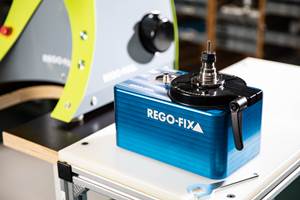Manufacturer Learns How To Use Cutting Tools More Effectively
In today's competitive climate, cutting tool manufacturers have to do more than just produce tools--they have to help customers use those tools effectively.
Share





In today's competitive climate, cutting tool manufacturers have to do more than just produce tools—they have to help customers use those tools effectively. At least that's the philosophy adopted by metalworking companies such as Mar-Metal, Inc. (Upper Sandusky, Ohio), a maker of thermoform tooling for packaging and other industries.
"We realized that in order to continue moving ahead, we had to build partnerships with suppliers," says Craig Marshall, vice president of Mar-Metal.
After interviewing representatives of tooling manufacturers, Carboloy, with its line of Seco-Carboloy tooling, was chosen as Mar-Metal's prospective partner. It was then up to Carboloy to prove that the decision was the right one.
First came an initial series of discussions including Frank Weeks, the local Carboloy technical specialist, Mr. Marshall and key Mar-Metal personnel. Mr. Weeks' aim was to gain an understanding of Mar-Metal's business direction, to identify business concerns and to explain Carboloy's approach to identifying opportunities for productivity improvements and cost savings.
Mr. Weeks assembled a process improvement team comprised of several Carboloy tech specialists based in Ohio. The team conducted a process survey of the entire machining operation at Mar-Metal. Based on the results, Mr. Weeks and his team devised a multifaceted approach to help maximize productivity while maintaining Mar-Metal's high level of product quality. A key part of this approach was training.
"I spent a great deal of time on the shop floor, working with each and every machine operator in the plant," says Mr. Weeks. "We worked on the determination of cutting parameters, the methods of analyzing insert life and tool failure, as well as the key principles of milling and turning."
Springing from the training and the initial process survey came several specific improvement initiatives. These included a new way of machining the critical die plates. Made of 6061 aluminum, they ranged from 3 to 4 inches thick and from 48 to 72 inches square, holding from 48 to 72 cavities.
"Mar-Metal had been using an indexable insert drill to drill initial holes in all these cavities, then roughing out the hole by making 8-inch-deep circular passes with an indexable carbide end mill," says Mr. Weeks. "We suggested that we try helical milling with our Seco-Carboloy Super Turbo mills, eliminating the drilling altogether."
Designed for medium depths of cut and higher feeds, Super Turbo is suited for helical interpolation, plunge milling and a number of other cutting procedures. "We were able to shave approximately 40 hours off the machining time of each batch of die plates," says Mr. Weeks. "In addition, helical milling with the Super Turbo allowed us to go longer before indexing inserts.
"We had similar successes in tool steel," he continues. "The mold plates themselves are made of aluminum, but the shoes and the base plates and other components are made out of A2 or D2 tool steel, and our productivity increases with these components have been substantial. With the old method and tool, their depth of cut in D2 steel machining had been approximately 0.120 inch, with a feed rate of approximately 0.003 inch/tooth and about 300 surface feet per minute. Now we are taking a 0.200-inch depth of cut with a feed rate of 0.006 inch/tooth at 550 surface feet per minute—more than 100 percent increase in metal removal. To top it off, we are getting approximately three times the tool life."
Next came the introduction of Carboloy's new router cutter. The results have been described as impressive. The company is now using this tool on all its larger aluminum cavities.
Mr. Marshall says, "The rigidity and spindle combination of the Mori Seiki SV500 complemented this tooling application. We are roughing at 17,500 rpm and completing in approximately 15 minutes the roughing operations that previously took as long as 4 hours.
"Frank Weeks and his process improvement team have methodically introduced new methods and tooling throughout our shop, resulting in very substantial improvements to our productivity and, ultimately, to our bottom line," says Mr. Marshall.
Related Content
Five Common Mistakes Shops Make with ER Collets (And How to Prevent Them)
Collets play a crucial role in the machining process, so proper tool assembly and maintenance is important. Here are five potential pitfalls to avoid when using ER collets.
Read MoreParts and Programs: Setup for Success
Tips for program and work setups that can simplify adjustments and troubleshooting.
Read MoreThe Future of High Feed Milling in Modern Manufacturing
Achieve higher metal removal rates and enhanced predictability with ISCAR’s advanced high-feed milling tools — optimized for today’s competitive global market.
Read MoreCustom Workholding Principles to Live By
Workholding solutions can take on infinite forms and all would be correct to some degree. Follow these tips to help optimize custom workholding solutions.
Read MoreRead Next
Building Out a Foundation for Student Machinists
Autodesk and Haas have teamed up to produce an introductory course for students that covers the basics of CAD, CAM and CNC while providing them with a portfolio part.
Read More5 Rules of Thumb for Buying CNC Machine Tools
Use these tips to carefully plan your machine tool purchases and to avoid regretting your decision later.
Read MoreRegistration Now Open for the Precision Machining Technology Show (PMTS) 2025
The precision machining industry’s premier event returns to Cleveland, OH, April 1-3.
Read More























.png;maxWidth=300;quality=90)









